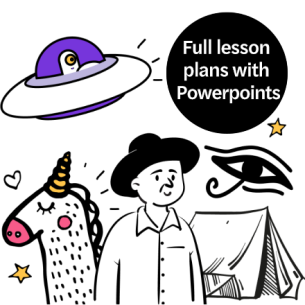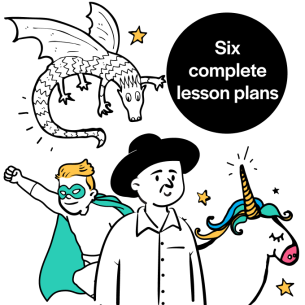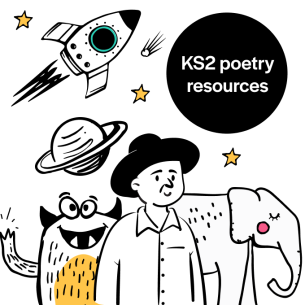Get children adding a bit of grammatical spice to their sentences with these teaching tips and KS2 adverbials resources from Laura Dobson…
Adverbials are the herbs and spices in a grammatical meal. They turn a fairly plain sentence into a culinary masterpiece. Their flexibility within a sentence allows you to play around with the effect you want to create.
What is an adverbial?
An adverbial is a group of words that act as an adverb and modify the main clause in the sentence. Adverbials tell you when, where, how or why an action occurs.
Adverbial phrases do not include a verb. Adverbial clauses do have a verb, but the clause will be subordinate to the main clause in the sentence.
An example of an adverbial clause is: When Charlie knocked on the door, Max stopped studying. (The adverbial clause here tells us why and when Max stopped studying.)
Try not to overthink grammar and get bogged down in the terminology. ‘Adverbials’ is an umbrella term to describe adverbs, prepositions and many subordinate clauses.
Ultimately, just ask yourself, “Is this part of the sentence telling me when, where or how the verb in the main clause happened?” If it is, then you are looking at an adverbial phrase or clause.
Putting adverbials to use in KS2
The end of the KS2 writing framework talks about ‘assured and conscious control’. It is referring to levels of formality. However, adverbials also allow young writers to demonstrate assured and conscious control.
By deciding where in the sentence the adverbial phrase or clause is, a writer can move the reader’s focus within the sentence and develop atmosphere.
Adverbials revision
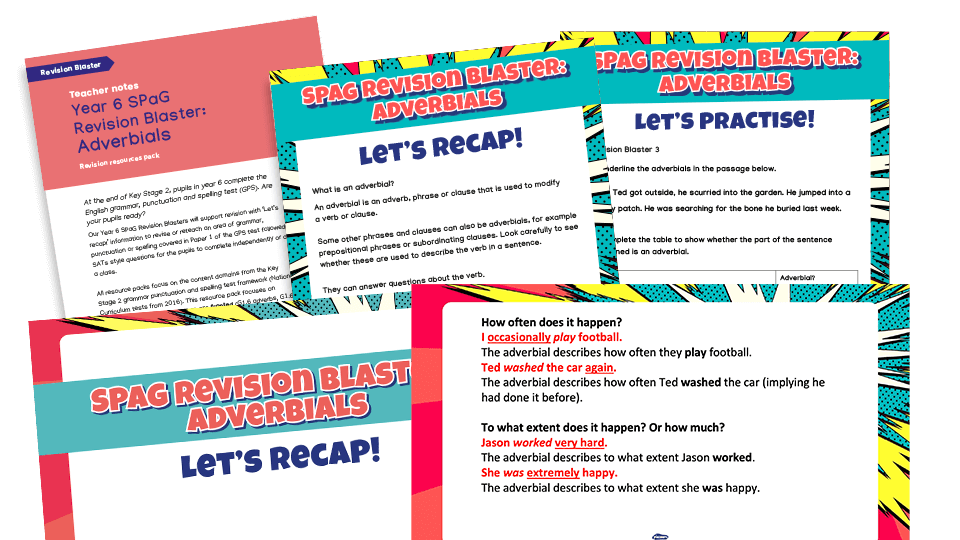
This Year 6 adverbials revision resource from literacy resources website Plazoom includes a ‘Let’s Recap’ section to reteach core concepts and a ‘Let’s Practise’ section with SATs-style questions that increase in difficulty across three worksheets. It comes with a PowerPoint for class or group work, as well as printable PDFs and answer sheets.
Building on a simple sentence
The swimmers continued their challenge.
How?
The swimmers continued their challenge with trepidation.
Where?
The swimmers continued their challenge with trepidation across the Channel.
Where? … continued…
In harsh conditions and stormy waters, the swimmers continued their challenge with trepidation across the Channel.
What if I reorder the adverbials to create a stronger effect?
With trepidation, in harsh conditions and stormy waters, the swimmers continued their challenge across the Channel.
In this example, I want to add in additional adjectives to make it more impactful…
With trepidation, in harsh conditions and stormy waters, the brave swimmers continued their gruelling challenge across the Channel.
Now I’m starting to think that maybe the sentence would work better without the ‘With trepidation’ at the start…
Let’s consider the example above, which illustrates the thought process a child might go through when considering how to use adverbials to build on a simple sentence.
This is the level of thought you want children to be going through when they build sentences using adverbial phrases.
They should be thinking about the effect their word choices and the word order will have on the reader. You want them to consider whether they have enough information in the sentence and, conversely, whether they have too much and therefore need to omit some words or phrases.
Exploring adverbials practically in KS2
I think this level of experimentation is best done by physically moving sentence parts around, rather than writing in a book with a pen and paper.
Doing it as a physical activity allows for collaboration and conversation around choice and effect. Pen and paper feel more final – they don’t allow for the experimentation that adverbs really require and truly deserve.
As a school, we have been using colourful semantics for a number of years as a speech and language intervention. The approach, created by Alison Bryan, helps children develop their understanding of sentence structure and expand their sentences.
When creating sentence-building activities as a school, we use the same colours as those detailed in the approach. This allows links to be made between the intervention and the learning in class.
Even if you don’t use colourful semantics as a school, I still highly recommend this sentence building approach.
KS2 adverbial resources
The download at the top of this page contains the following adverbial resources:
Worksheet 1 and Slide pack 1: These use the colourful semantics approach to develop sentence construction understanding with a Year 3 class using Sophie Kirtley’s book, The Wild Way Home.
Worksheet 2: This follows the colourful semantics colours. Use it with Slide Pack 1. The cards are linked to a text our Year 4 classes use: The Wolves of Currumpaw by William Grill.
Worksheet 3: This provides children with a range of adverbials, colour-coordinated according to their purpose. Ask pupils to work out which colour correlates with which purpose (when, where and how). Then give them a simple sentence or get them to write one. Now challenge them to build the sentence up using the adverbials. You may decide to add adjectives, etc, too.
Worksheet 4: This is a game called Does it work? For this game, you will need a 1–10 dice or a spinner. The instructions are at the top of the sheet. This game allows children to consider sense when building sentences.
‘As still as a statue, the lions roared.’ This is nonsensical because the adverbial doesn’t relate to the verb ‘roared’. In the adverbial the singular ‘a’ is used but in the main clause it is the plural ‘lions’.
Children may not describe these things technically, but a more general discussion around sense will ultimately lead to more thoughtful writing.
Warm-up games
The best grammar teaching is embedded into units of work where children can:
- see the grammar in context
- practise using the grammar through discrete skills-based activities
- use the grammar when writing in a similar style to the model they saw at the start
- practise regularly to maintain the newly acquired knowledge
Grammar games are an excellent way of providing repeated practice. A simple game for KS2 is to put a variety of adverbials into a hat (you can use Worksheet 3 for this). Pull one out and have the children write it on their mini whiteboards, then complete the sentence.
Consequences
You could also play a good old-fashioned game of Consequences, but with sentence structure.
- Each child gets a piece of paper.
- They write a time adverbial, fold it over and pass it to the next child.
- Next, they write a place adverbial (on the piece of paper which has been handed to them), fold it over and pass it on again.
- Then, they write an adjective, fold it over and pass it on.
- Next, they write the subject (who), fold it over and pass it on.
- Now, they write the verb (what), fold it over and pass it on.
- Then, they write an adverb, fold it over and pass it on.
- Finally, they write the object (to, what or who).
- Each child then unfolds their paper and reads the sentence through. The sentences may not make sense, but they will make the class laugh. It’s a great way to recap the parts of a sentence.
Laura Dobson is a teaching and learning consultant with a passion for primary English.
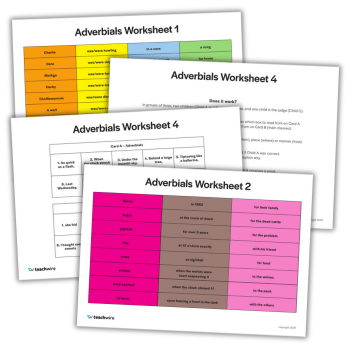
Similar resources
- No Refuge – Graphic novel activities about refugees for UKS2
- Short story writing – Author-led resources for KS1 and KS2
- Christmas activity sheets – KS1 / KS2 fun & educational printables
- Learning gaps – How to ensure no pupil drifts too far
- Writing horror – Write a scary scene with Fear Files: Hide & Seek



